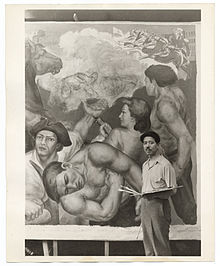Eitaro Ishigaki
Eitaro Ishigaki | |
|---|---|
石垣 栄太郎 | |
 Eitaro Ishigaki, c. 1940, from the Archives of American Art | |
| Born | December 1, 1893 Taiji, Wakayama, Japan |
| Died | January 23, 1958 (aged 64) |
| Nationality | American |
| Known for | Painting, muralist |

Eitaro Ishigaki (石垣 栄太郎, Ishigaki Eitarō, December 1, 1893 – January 23, 1958) was an American artist.[1]
Life[]
Eitaro Ishigaki was born in Taiji, Wakayama, Japan in 1893. At the age of sixteen he emigrated to America in to live with his father in Seattle. A year later, in 1910, they moved to California, and in 1912, Ishigaki moved to San Francisco. There he met many artists, including Gertrude Boyle, and attended class at both the William Best School of Art and at the San Francisco Institute of Art.[1] Eitaro Ishigaki was a founding member of the John Reed Club and a member of the Federal Art Project as well.[2] In the 1930s, he was also involved in the Artists Congress and other WPA activities.[1]
In 1937, he painted two murals at the Harlem Courthouse, American Independence and Emancipation.[3] In 1938, the New York City Council ruled both of them offensive and murals were removed.[4]
His painting, Man on the Horse (1932), depicted a plain-clothed Chinese guerrilla confronting the Japanese army, heavily equipped with airplanes and warships. His other painting, Flight (1937), depicted two Chinese women escaping Japanese bombing, running with three children past one man lying dead on the ground.[5]
During World War II, he worked for the United States Office of War Information.[6] In 1951, Ishigaki was arrested and deported to Japan with his wife, Ayako Ishigaki, where he died after seven years.[2]
Recognition[]
His work is held by the Art Institute of Chicago.[7] In 1997 and 2013, the Museum of Modern Art, Wakayama held commemorative exhibitions of his works.[8] His work is also located in the Ishigaki Eitaro Memorial Museum in Wakayama, Japan.[1]
Works[]
- "Undefeated Arm" (cover) New Masses(July 1929)[9]
- "May Day" New Masses (May 1930)[10]
See also[]
- Japanese resistance to the Empire of Japan in World War II
References[]
- ^ Jump up to: a b c d Gordon H. Chang; Mark Dean Johnson; Paul J. Karlstrom; Sharon Spain, eds. (2008). Asian American art, 1850-1970. Stanford University Press. ISBN 978-0-8047-5752-2.
- ^ Jump up to: a b Japanese Artists In New York Between The World Wars
- ^ The American Scene Art of the 1930s and 1940s, Harlem Courthouse Mural study
- ^ Race, ethnicity and migration in modern Japan / edited by Michael Weiner. London: Routledge, 2004, p. 333.
- ^ Race, Ethnicity and Migration in Modern Japan: Imagined and imaginary minorities Page 333
- ^ Michael Denning (1998). The cultural front: the laboring of American culture in the Twentieth Century. Verso. ISBN 978-1-85984-170-9.
- ^ Eitaro Ishigaki | The Art Institute of Chicago
- ^ Eitaro Ishigaki Retrospective, The Museum of Modern Art, Wakayama, 2013. Archive
- ^ "Undefeated Arm" (PDF). New Masses. July 1929. Retrieved 13 May 2020.
- ^ "May Day" (PDF). New Masses: 20. May 1930. Retrieved 13 May 2020.
Further reading[]
- Andrew Hemingway (2002). Artists on the left: American artists and the Communist movement, 1926-1956. Yale University Press. ISBN 978-0-300-09220-2.
- ShiPu Wang (2017). "By Proxy of His Black Heroes: Eitarō Ishigaki and the Battles for Equality." The Other American Moderns. Matsura, Ishigaki, Noda, Hayakawa. Penn State University Press. ISBN 978-0-271-07773-4.
| Wikimedia Commons has media related to Eitaro Ishigaki. |
- 1893 births
- 1958 deaths
- Federal Art Project artists
- American muralists
- American artists of Japanese descent
- Japanese expatriates in the United States
- 20th-century American painters
- American male painters
- People of the United States Office of War Information
- People from Wakayama Prefecture
- People deported from the United States